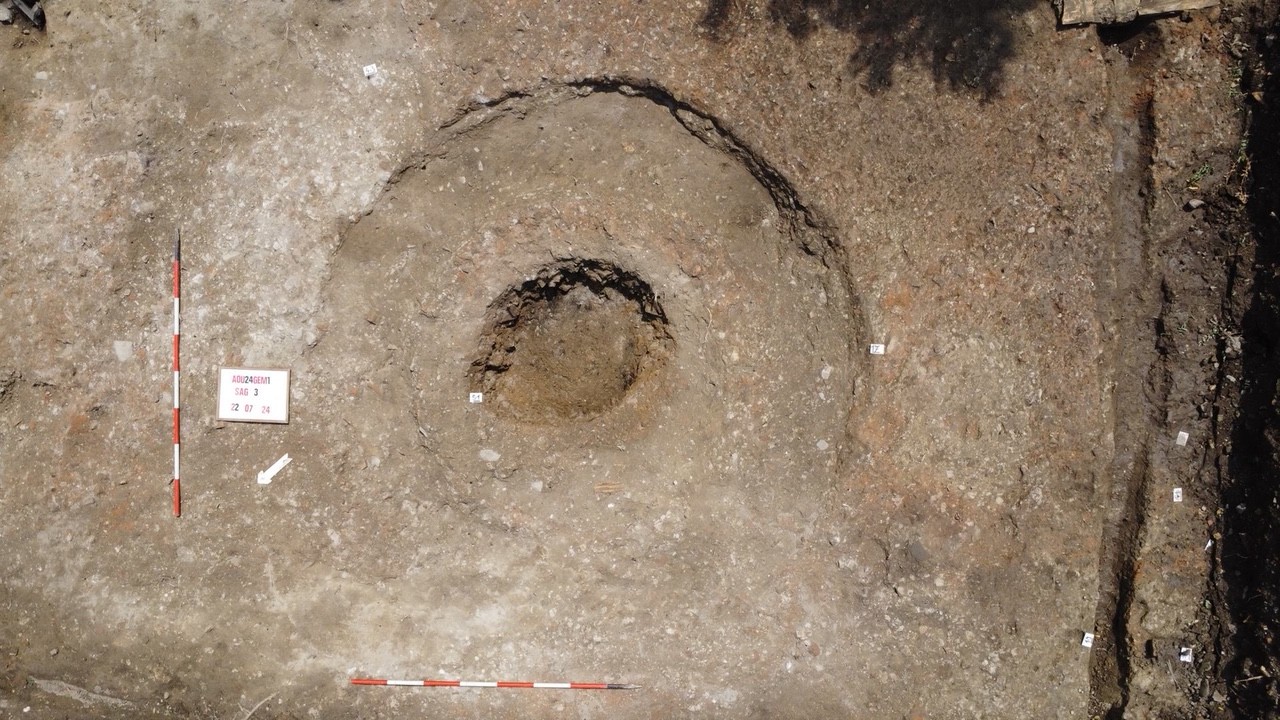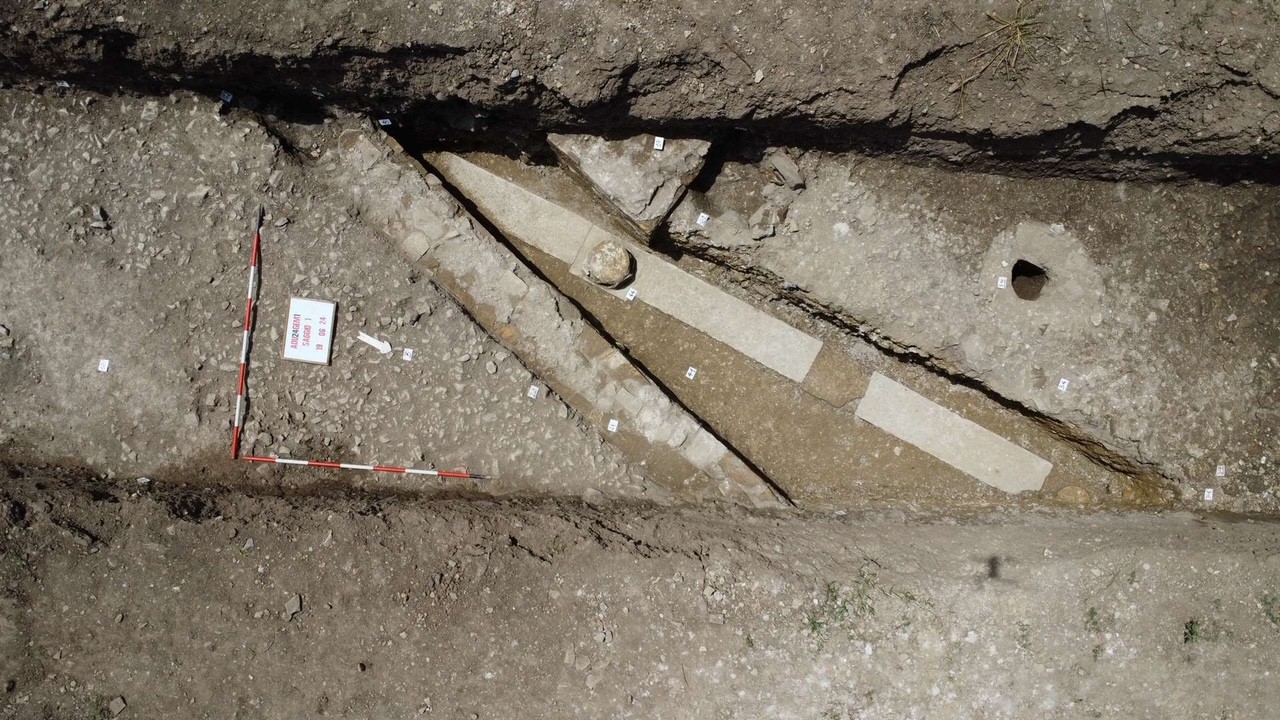AQUILEIA
PATRIMONIO DELL'UMANITÀ
sabato 13 dicembre 2025
Archaeological Finds Shed New Light on City's History
New discoveries in Aquileia: finds linked to production activities and a residential building from the Roman era resurface
Samantha De Martin - 25/10/2024
There is a Roman residential building, which has been uncovered with part of the peristyle colonnade, which must have been used initially as a production plant and then, in the late ancient period, as an agricultural area, perhaps connected to the nearby monastery. And there is another building likely intended for production activities related to the processing of cereals, as suggested by the traces of the ditch for the stripping of a large millstone surrounded by a groove left on the pavement by the continuous and repeated passage of those who moved it.
These important residential and production contexts, which add new pieces to the knowledge of the suburban landscape to the north-east of Aquileia, are part of the important archaeological finds discovered over the last few months in the locality of Monastero, in an area located immediately outside the urban layout of the ancient city. The investigations, currently underway, are being carried out as part of the Preventive Verification of Archaeological Interest procedure for the creation by the Municipality of Aquileia of a new stretch of cycle path on Via Gemina.

Latest discoveries in Aquileia, millstone | Courtesy Fondazione Aquileia
Begun last January, the excavations, coordinated by the archaeologist Dario Gaddi, were entrusted by the Municipality of Aquileia to the company ArcheoTest s.r.l., and are being carried out under the scientific direction of the archaeologist Serena Di Tonto for the Superintendence of Archaeology, Fine Arts and Landscape for Friuli Venezia Giulia. During the first phase, twelve surveys were carried out which confirmed the high archaeological risk of the entire sector north of Via Gemina, which had been the subject of explorations and investigations since the 19th century. In light of the initial results, the Superintendence requested further investigations to clarify the actual consistency of the archaeological evidence that had emerged and its chronology.
In the past, in this part of the suburb where the connecting roads with Emona (Ljubljana) and Tergeste (Trieste) ran, the investigations conducted had brought to light sectors of the monumental necropolises located at the sides of the roads, but there had been few structures connected to residential buildings. And instead the latest discoveries have highlighted structures pertaining to residential complexes, still under excavation, also revealing water drainage systems through amphorae and remains of a funerary nature, such as a ceramic olla containing burnt bones and ash, without grave goods. These latest testimonies document a second phase in which, in correspondence with the buildings, a cemetery area was subsequently established. All the other excavation interventions have returned contexts probably attributable to a productive vocation, even if it will be possible to know more only at the conclusion of the archaeological investigations and the preliminary phases of documentation and study on what has emerged.

"The excavations, recently started as part of the work on the cycle path that we will build with the aim of making slow mobility safe on the Monastero-Colombara stretch - underlined the mayor of Aquileia, Emanuele Zorino - have brought to light finds of extraordinary importance for the city. The remains of Roman residential buildings, with colonnades and porticoes, together with the finds of productive activities related to the processing of cereals, constitute a great enrichment for the fascinating picture of the development of the Roman city even in the suburban area."
These important residential and production contexts, which add new pieces to the knowledge of the suburban landscape to the north-east of Aquileia, are part of the important archaeological finds discovered over the last few months in the locality of Monastero, in an area located immediately outside the urban layout of the ancient city. The investigations, currently underway, are being carried out as part of the Preventive Verification of Archaeological Interest procedure for the creation by the Municipality of Aquileia of a new stretch of cycle path on Via Gemina.

Latest discoveries in Aquileia, millstone | Courtesy Fondazione Aquileia
Begun last January, the excavations, coordinated by the archaeologist Dario Gaddi, were entrusted by the Municipality of Aquileia to the company ArcheoTest s.r.l., and are being carried out under the scientific direction of the archaeologist Serena Di Tonto for the Superintendence of Archaeology, Fine Arts and Landscape for Friuli Venezia Giulia. During the first phase, twelve surveys were carried out which confirmed the high archaeological risk of the entire sector north of Via Gemina, which had been the subject of explorations and investigations since the 19th century. In light of the initial results, the Superintendence requested further investigations to clarify the actual consistency of the archaeological evidence that had emerged and its chronology.
In the past, in this part of the suburb where the connecting roads with Emona (Ljubljana) and Tergeste (Trieste) ran, the investigations conducted had brought to light sectors of the monumental necropolises located at the sides of the roads, but there had been few structures connected to residential buildings. And instead the latest discoveries have highlighted structures pertaining to residential complexes, still under excavation, also revealing water drainage systems through amphorae and remains of a funerary nature, such as a ceramic olla containing burnt bones and ash, without grave goods. These latest testimonies document a second phase in which, in correspondence with the buildings, a cemetery area was subsequently established. All the other excavation interventions have returned contexts probably attributable to a productive vocation, even if it will be possible to know more only at the conclusion of the archaeological investigations and the preliminary phases of documentation and study on what has emerged.

Latest discoveries in Aquileia | Courtesy Fondazione Aquileia
"The excavations, recently started as part of the work on the cycle path that we will build with the aim of making slow mobility safe on the Monastero-Colombara stretch - underlined the mayor of Aquileia, Emanuele Zorino - have brought to light finds of extraordinary importance for the city. The remains of Roman residential buildings, with colonnades and porticoes, together with the finds of productive activities related to the processing of cereals, constitute a great enrichment for the fascinating picture of the development of the Roman city even in the suburban area."
Spotlight
See allThe wonders of Tito Macro's domus
The largest 'Pompeian' residence discovered in Northern Italy is found in Aquileia: it is the domus of Tito Macro. A large house of which the extraordinary mosaics are preserved, evidence of the style and taste of the ancient inhabitants of the Roman city, an ancient crossroads between Europe and the Mediterranean.From Salento to Aquileia, a bridge of folk music
The project "From Salento to Aquileia" is starting in Aquileia, promoted by the La Notte della Taranta Foundation in collaboration with the Aquileia FoundationNews
See all
Udine | New discoveries from the Ex Pasqualis site
Three ancient coins emerge from the soil of Aquileia, revealed by recent excavations
The recent excavation campaign has brought to light three gold coins of the emperors Valens, Magnus Maximus, and Arcadius, which had been hidden for centuries beneath the floor of a marketplace portico.
Udine | Saturday, October 18th at 6:30 PM in Aquileia
From Salento to Aquileia, a bridge of folk music
The project "From Salento to Aquileia" is starting in Aquileia, promoted by the La Notte della Taranta Foundation in collaboration with the Aquileia Foundation
Udine | In Aquileia on September 27 and 28, 2025


